Verdict
More powerful than the HP Omen Transcend 14 and cheaper than the Asus ROG Zephyrus G14, the Lenovo Legion Slim 5 Gen 8 is a perfect blend of high performance, efficiency, portability and affordability.
Pros
- Superb OLED display
- Impressive performance
- Decent battery life
- Space for a second SSD
Cons
- RAM isn’t user-upgradeable
- Conservative styling
-
RTX 4060 graphics chipFeatures a 105W TGP, offering fast Full HD gaming -
Lightweight and compactAt just 1.7Kg this is one of the lightest compact gaming laptops on the market -
OLED screenThe 120Hz OLED display is fluid, vivid and perfect for HDR content
Introduction
High-end compact gaming laptops are like buses: you wait ages for one, and then three come along at once.
We recently tested Asus ROG’s excellent but expensive Zephyrus G14 and HP’s rather tasty Omen Transcend 14. Today, it’s the turn of Lenovo’s variation on the theme, the Legion Slim 5 Gen 8.
The three machines have many similarities. They all have 14-inch 2.8K 120Hz OLED screens, use Nvidia RTX 40-series GPUs, as well as AMD CPUs in the case of the Legion Slim 5 and Zephyrus G14.
Those high-end OLED screens also indicate that these machines are aimed as much at creatives as consumers, which puts them in direct competition with Apple’s MacBook Pro.
Design and Keyboard
- Excellent array of I/O ports
- All-aluminium construction
- High-quality ThinkPad-like keyboard
Weighing 1.7 kg, the Lenovo Legion Slim 5 is the same weight as the Omen Transcend 14 but slightly heavier than the 1.5 kg Zephyrus G14. At 328x251x21.3mm, the Lenovo is a tad bigger than the HP or Asus machines, but remember that the Legion Slim 5 has a larger display 14.5-inch screen, so it has every right to be a little larger than the competition.
Made entirely from aluminium, the Legion Slim 5 is impressively solid, while the Storm Grey anodised finish proved impressively resilient to greasy fingerprints.
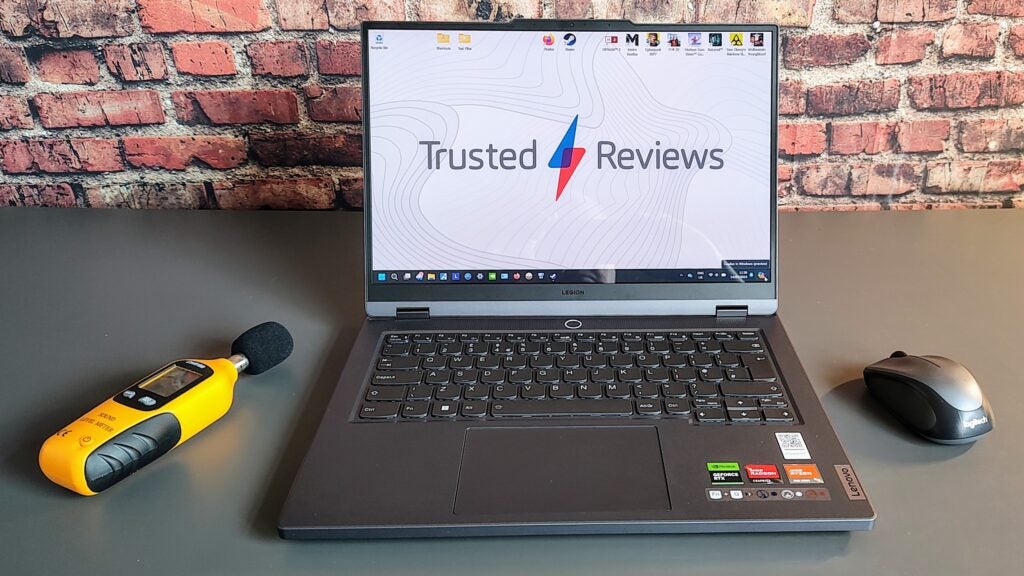
Compared to the HP, Asus and Apple alternatives, the Lenovo looks rather dull; it is more ThinkPad-functional than the gamer-flash of the stylish Asus and HP machines. Of course, in some circumstances, having a more sober and grown-up-looking laptop may be a good thing, so I’ll not beat the Lenovo too hard for its conservative styling.
Lenovo has undoubtedly designed a very practical machine. On the left side, you will find two USB-C 3.2 Gen 2 ports, while on the back is an HDMI 2.1 video output, two USB-A 3.2 Gen 2 ports, and a proprietary rectangular power jack. Rounding things out on the right side are an SD card reader, a 3.5mm audio jack, and a webcam isolator.
With both Type-C ports supporting DP Alt Mode video output, it makes for a comprehensive and well-organised selection of I/O ports that only the Zephyrus G14 comes close to matching.
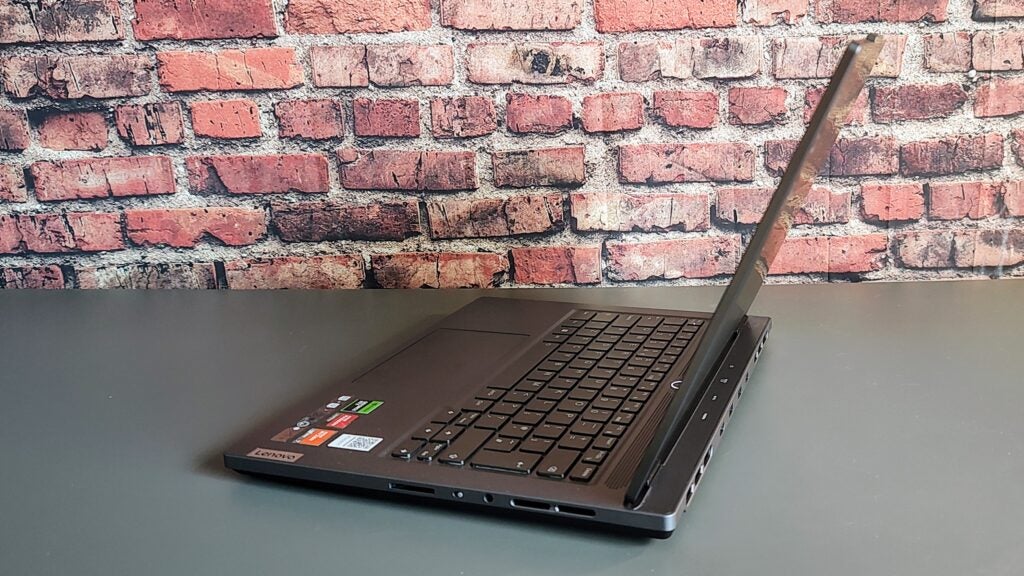
Wireless communications are handled by a MediaTek RZ616 card, which supports 6Ghz W-Fi 6E and Bluetooth 5.2. It looks a little dated compared to the card inside the Omen Transcend 14, which supports the latest Wi-Fi 7 and Bluetooth 5.4, while the Zephyrus G14 supports Wi-Fi 6E and low audio latency Bluetooth 5.3.
Look at the top of the ledge that protrudes behind the lid hinge, and you’ll see an example of the attention to detail that typifies Lenovo design. Each of the rear ports has a clear logo above it on the ledge, so you can easily locate them without having to feel for them or spin the laptop around.
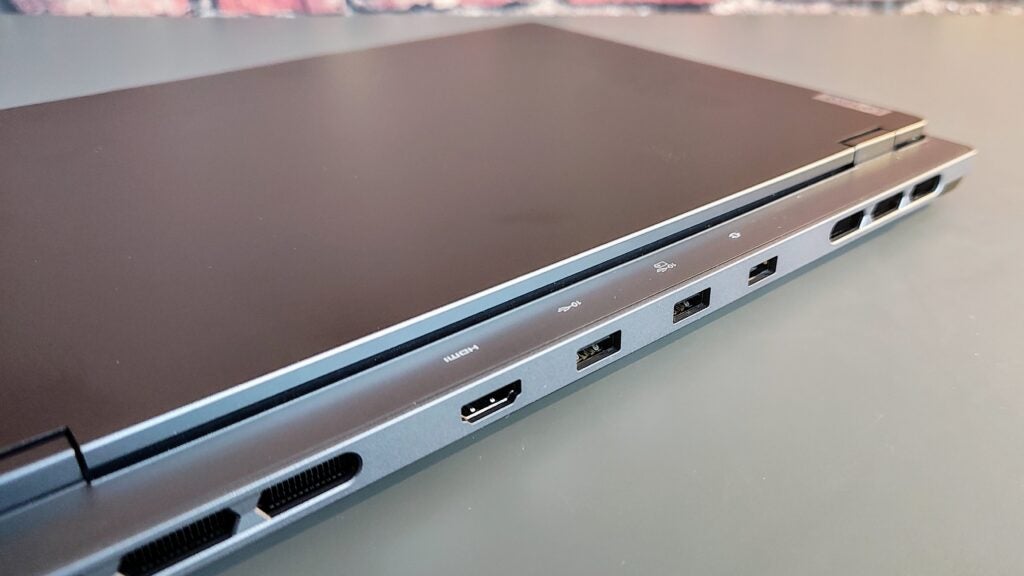
The TrueStrike keyboard could have been pinched from a ThinkPad laptop. That’s good because it’s pleasant to type on with a precise action and perfect 1.5mm of travel, but bad because it lacks any gaming features like a distinguished WASD array, be it by a physical design or lighting effect. The backlight is an effective but mundane two-stage white affair.
The only nod to the gaming fraternity is the Fn+Q and FN+R shortcuts that let you cycle through power modes and display refresh rates, respectively.
The buttonless glass surface multi-touch trackpad worked perfectly and, at 120 x 75mm, is about as large as it could be given the size restrictions inherent in a 14.5-inch laptop body. The click-action was very quiet, something I appreciated while working in Manchester Central Library for an afternoon.
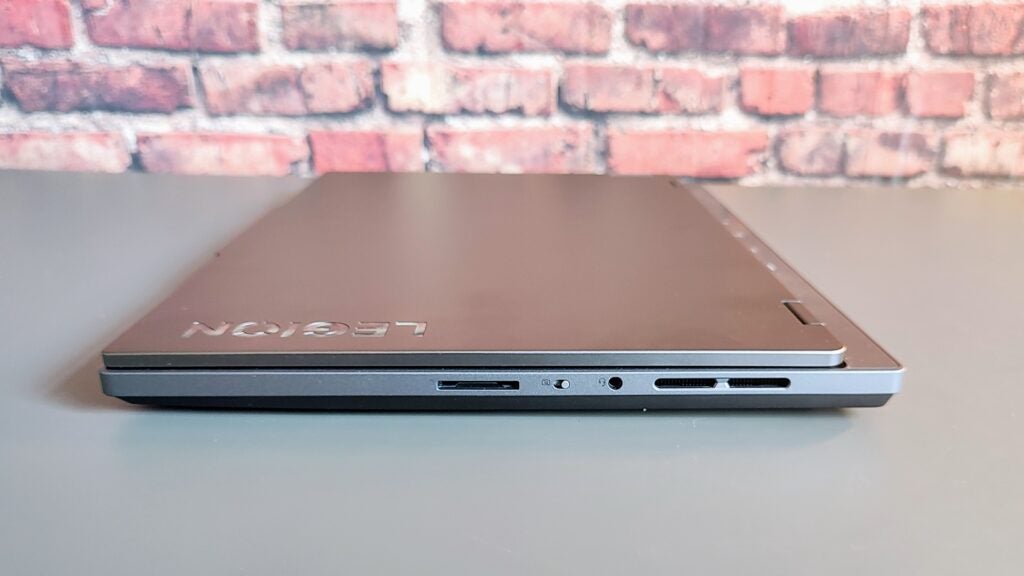
The only biometric login option is a fingerprint reader built into the large power button below the centre of the screen. The LED light that surrounds the power button changes colour depending on the power setting you choose, which is a nice design touch.
Removing the base panel from the Legion Slim 5 is straightforward. While you can’t upgrade the RAM, which is soldered in place, you can easily add a second 2280 PCIe 4 SSD, a must-have feature of a serious gaming laptop, given the ever-increasing size of modern AAA titles.
Screen and Sound
- 2.8K 120Hz OLED panel
- Wide colour gamuts
- Excellent motion fidelity
I am thoroughly impressed by the Legion Slim 5’s 14.5-inch 2880 x 1800 OLED screen. It’s usefully bright, hitting 385nits in SDR mode and 615nits in HDR mode, the latter more than sufficient to earn the display its VESA HDR500 rating.
It’s a colourful display with gamut coverages of 100% sRGB, 98.7% DCI-P3 and 93.7% Adobe RGB. With such high levels of colour and brightness, content looks very impressive on the Legion Slim 5, especially HDR video, which really pops out at you, helped by the glossy panel finish.
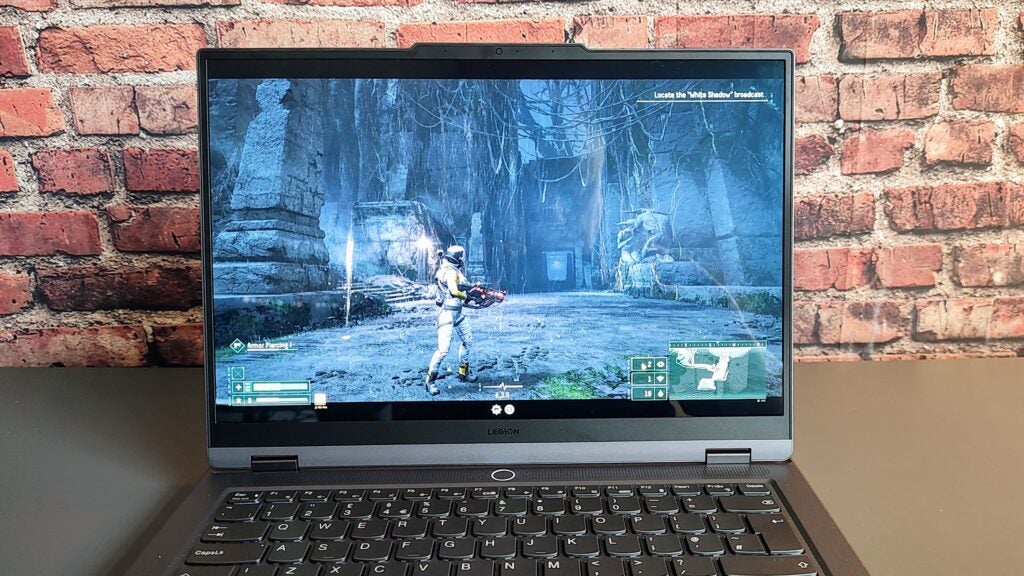
The Legion Slim 5 comes pre-installed with the X-Rite Color (sic) Assistant app, which lets you swap the display colour profile between AdobeRGB, DisplayP3, sRGB, Rec.709, and a default setting. Testing the Delta E variance against the first three profiles returned scores of 1.8, 1.0 and 0.9, respectively, which means the Legion Slim 5 can be used for colour-critical work out of the box without further calibration.
The combination of the 120Hz refresh rate and the low G2G response rates inherent in OLED technology means that motion fidelity is good, with very little ghosting or smearing noticeable. This makes the screen ideal for both gaming and CAD animations.
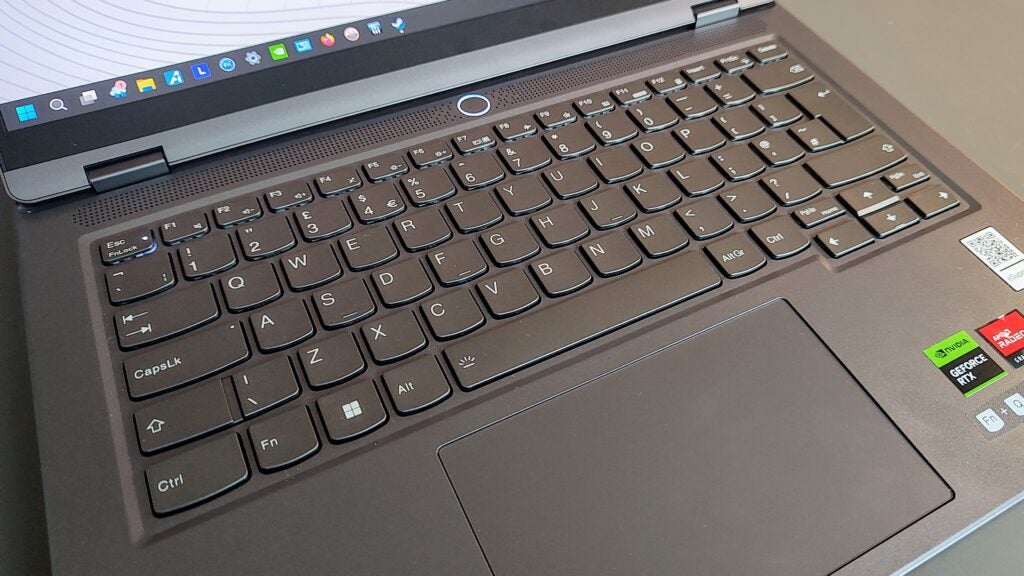
On paper, the speaker system is a basic 2 x 2W affair with Nahimic sound modification. Still, it produces an impressive amount of volume, pumping out 78dB(A) measured against a pink noise source. The sound also lands easily on the ear, with a decent amount of bass, impressive detail levels and an expansive soundscape.
Lenovo makes few claims regarding the Legion Slim 5’s environmental impact other than that it meets the middle EPEAT Silver certification for recyclability and harmful substance mitigation. The packaging uses two large polystyrene bumpers to keep the laptop safe when in transit, which is less than ideal from an environmental perspective.
Performance
- Ryzen 7 7840HS and RTX 4060 (105W) combo
- MUX switch for optimal GPU performance
- Fast SSD with high sequential read and write speeds
Running the show in my test machine was an AMD Ryzen 7 7840HS CPU and Nvidia RTX 4060 GPU with a TGP of 105W. The 7840HS isn’t one of AMD’s latest ultra-powerful Dragon Range or AI-friendly Hawk Point CPUs, but it is a powerful and efficient 8-core affair with a maximum clock of 5.1GHz.
In the Cinebench R23 multi-core test, the Lenovo scored 17,164, ahead of the Omen Transcend 14 (13,399) and the Zephyrus G14 (15,946). The new Lenovo takes the field in the PCMark 10 challenge too, scoring 7832 to the Zephyrus G14’s 7192 and the Omen Transcend’s 5,957.
If you still fancy something with even more performance, you can specify the AMD Ryzen 9 7940HS CPU for an extra £150, but I don’t think the difference in performance is worth that sort of money. Spending an extra £50 to double the 16GB of LPDDR5X-6400MHz RAM, on the other hand, is probably a good use of your hard-earned cash.
Regarding synthetic graphics tests, the Lenovo has HP Omen Transcend beaten like the family mule, scoring 10,607 in the 3DMark Time Spy to the Omen’s 5,947. The RTX 4070-powered Zephyrus G14 scored 11,116 thanks to its restrictive 90W TGP. That difference is so small as to be unnoticeable in real-world use.
Playing Cyberpunk 2077 at QHD without ray tracing, the Legion Slim managed an average frame rate of 41fps, compared to the Zephyrus 14 and Omen Transcend 14, which managed around 30fps. Turn ray tracing on, and the frame rate takes a dive: the Legion Slim 5 manages only 33fps at FullHD, compared to 32fps for the Zephyrus G14 and 21.5fps for the Omen Transcend 14.
Of course, when it comes to ray tracing, Nvidia’s DLSS 3.5 upscaling and Frame Generation technology comes to your rescue. With ray tracing set to Ultra, DLSS on Balanced, and Frame Generation on and running at 1920 x 1200, the Legion Slim 5 managed 80fps, which is impressive by any standards.
Lenovo has chosen well with the 1TB SKHynix PCI4 4 SSD, which recorded impressively uniform sequential read and write speeds of 5874MB/s and 5750MB/s, respectively. That’s the fastest write speed I’ve ever encountered in a laptop without a RAID arrangement.
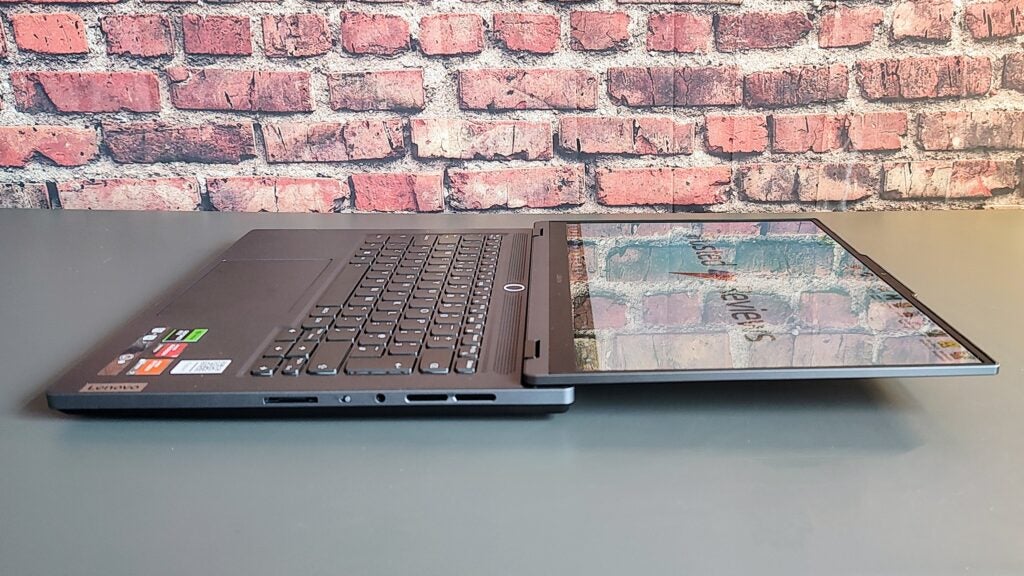
The Legion Slim 5 demonstrated impressive thermal management and ran the CPU and dGPU at 100% for a full hour without any performance drop-off. The centre of the keyboard deck hit a maximum temperature of 39°C, which is not bad for a small machine with a powerful dGPU inside, and the fan noise never exceeded 58.5dBA, among the lowest figures I’ve recorded from a laptop with serious gaming pretentiousness.
Software
- Lenovo Vantage app configuration tool
- Legion Arena games library app
- Lenovo Hotkeys keyboard management app
Lenovo has split the hardware and game library management roles between two separate apps: Lenovo Vantage for the former and Lenovo Arena for the latter. It’s a clever move because both apps are easy to navigate and master without flicking through countless tabs.
Usefully, Arena lets you manually add games directly off your hard drive that you may have acquired by nefarious methods alongside your kosher Steam and Ubisoft Connect titles.
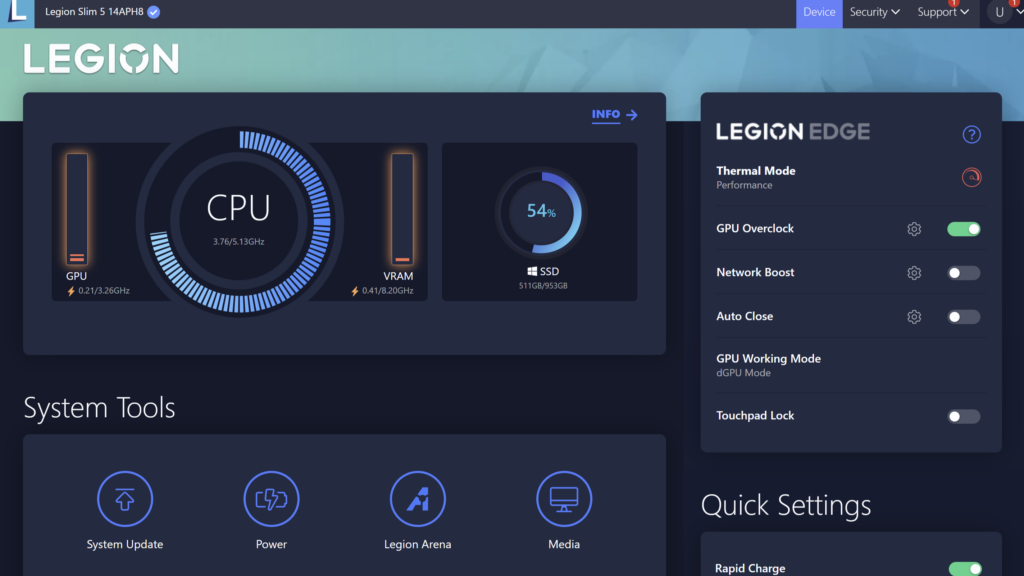
Other pieces of software worth keeping include the Nahimic sound control panel, the X-Rite display manager and Lenovo’s Hotkeys app, which lets you assign various functions to the F9 key.
The AMD Ryzen 7 7840HS processor lacks the AI smarts provided by the NPUs inside the latest AMD and Intel processors, so the 1080p webcam lacks Microsoft’s Studio effects like blurred background and gaze tracing. Otherwise, it does a decent job, though there is rather a lot of noise in lower-light environments.
Battery Life
- 73.6Wh capacity battery
- Just enough power for a full day of work
Regarding battery life, the Lenovo Legion Slim 5 beats both the Omen Transcend 14 and Zephyrus G14 but not the MacBook Pro.
Running the PCMark 10 Modern Office benchmark, the Legion lasted just over six and three-quarter hours. Using it as my daily driver, I could reach the end of the working day more often than not, even if I was running on fumes by clocking out time.
That run-time was achieved with the MUX switch set to take the Nvidia dGPU out of the equation. Run tasks requiring the discrete GPU, and that battery time can be cut in half.
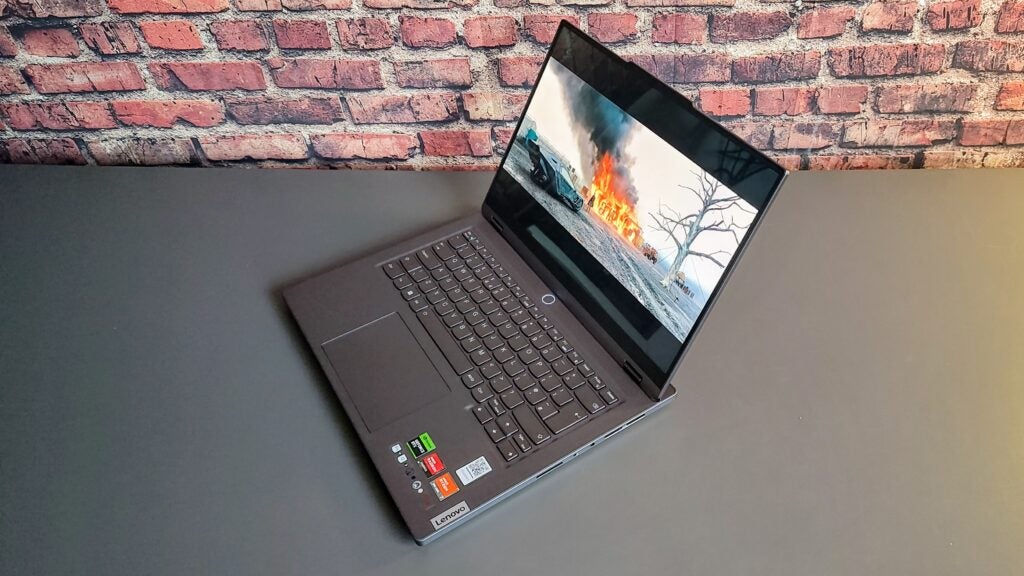
For video streaming, an hour of Netflix with the brightness turned up to 80% drained the battery by 12%, while looping a locally stored 1080p video using VLC did the same in 8 hours and 30 minutes.
According to Lenovo, you can charge the Legion Slim 7 via the front Type-C port, but you’ll need a 140W charger. It certainly wouldn’t play ball with my 100W charger. The proprietary 170W charger in the box is among the smallest and lightest I’ve encountered.
Latest deals
Should you buy it?
If you want a compact laptop that can do everything
If you want a powerful, omnicompetent laptop for serious gaming and equally serious creative work that won’t break the bank, the Legion Slim 5 14 should be high on your list of potential candidates. For the price, it is simply outstanding.
If you must have latest AI technology
The only negative thing I can think of about the Legion Slim 5 14 is that the processor is not the latest, so it lacks the AI Neural Processor found in the latest Intel and AMD silicon. Is that a good reason not to buy it? Not in my book.
Final Thoughts
Where Lenovo scores over the competition is in price: a fully-loaded Lenovo Legion Slim 5 14 Gen 8 with a 1TB SSD and 32GB of RAM only costs £1474. That makes it a genuine bargain.
The HP Omen Transcend 14 range starts at £1699, but that only gets you an RTX 4050 GPU. Upgrading to the RTX 4060 moves the price to £1799, which still only bags you 16GB of RAM. Apple’s new M3 MacBook Pro 14 range starts at £1699, and for that, you must suffer with a 512GB SSD. The 1TB model costs £200 more. The Asus ROG Zephyrus G14 will set you back £1899.99 for the RTX 4060 version on Amazon.
Of course, there are many gaming/creative laptops that can give the Legion Slim 5 a good spanking when it comes to performance like the Asus ROG Zephyrus G16 but they are much bigger, much heavier and much more expensive. If you are looking for the perfect intersection of performance, value and convenience, that’s where you’ll find the Legion Slim 5 14 Gen 8. Check out our Best Laptop and Best Gaming Laptop guides for more options.
How we test
Every laptop we review goes through a series of uniform checks designed to gauge key things including build quality, performance, screen quality and battery life.
These include formal synthetic benchmarks and scripted tests, plus a series of real-world checks, such as how well it runs popular apps.
We used the device as our main laptop for at least a week.
Tested the performance via both benchmark tests and real-world use.
We tested the battery with a benchmark test and real-world use.
FAQs
Lenovo advertises the Legion Slim 5 as a 14-inch device but the screen is 14.5 inches corner-to-corner. That makes it bigger than even the 14.2-inch MacBook Pro 14.
The Nvidia GeForce RTX 4060 GPU is rated at 105 watts maximum graphics power and has 8GB of vRAM.
Trusted Reviews test data
PCMark 10
Cinebench R23 multi core
Cinebench R23 single core
Geekbench 5 single core
Geekbench 5 multi core
Geekbench 6 single core
Geekbench 6 multi core
3DMark Time Spy
CrystalDiskMark Read speed
CrystalDiskMark Write Speed
Brightness (SDR)
Brightness (HDR)
Black level
Contrast ratio
White Visual Colour Temperature
sRGB
Adobe RGB
DCI-P3
PCMark Battery (office)
Battery discharge after 60 minutes of online Netflix playback
Horizon Zero Dawn frame rate (Quad HD)
Horizon Zero Dawn frame rate (Full HD)
Cyberpunk 2077 (Quad HD)
Cyberpunk 2077 (Full HD)
Cyberpunk 2077 (Full HD + RT)
Cyberpunk 2077 (Full HD + Supersampling)
Returnal (Quad HD)
Returnal (Full HD)
F1 22 (Quad HD)
F1 22 (Full HD)
Fan noise under stress
Temperature under stress
UK RRP
CPU
Manufacturer
Screen Size
Storage Capacity
Front Camera
Battery
Battery Hours
Size (Dimensions)
Weight
Operating System
Release Date
First Reviewed Date
Model Number
Resolution
HDR
Refresh Rate
Ports
Audio (Power output)
GPU
RAM
Connectivity
Colours
Display Technology
Touch Screen
Convertible?
Verdict
More powerful than the HP Omen Transcend 14 and cheaper than the Asus ROG Zephyrus G14, the Lenovo Legion Slim 5 Gen 8 is a perfect blend of high performance, efficiency, portability and affordability.
Pros
- Superb OLED display
- Impressive performance
- Decent battery life
- Space for a second SSD
Cons
- RAM isn’t user-upgradeable
- Conservative styling
-
RTX 4060 graphics chipFeatures a 105W TGP, offering fast Full HD gaming -
Lightweight and compactAt just 1.7Kg this is one of the lightest compact gaming laptops on the market -
OLED screenThe 120Hz OLED display is fluid, vivid and perfect for HDR content
Introduction
High-end compact gaming laptops are like buses: you wait ages for one, and then three come along at once.
We recently tested Asus ROG’s excellent but expensive Zephyrus G14 and HP’s rather tasty Omen Transcend 14. Today, it’s the turn of Lenovo’s variation on the theme, the Legion Slim 5 Gen 8.
The three machines have many similarities. They all have 14-inch 2.8K 120Hz OLED screens, use Nvidia RTX 40-series GPUs, as well as AMD CPUs in the case of the Legion Slim 5 and Zephyrus G14.
Those high-end OLED screens also indicate that these machines are aimed as much at creatives as consumers, which puts them in direct competition with Apple’s MacBook Pro.
Design and Keyboard
- Excellent array of I/O ports
- All-aluminium construction
- High-quality ThinkPad-like keyboard
Weighing 1.7 kg, the Lenovo Legion Slim 5 is the same weight as the Omen Transcend 14 but slightly heavier than the 1.5 kg Zephyrus G14. At 328x251x21.3mm, the Lenovo is a tad bigger than the HP or Asus machines, but remember that the Legion Slim 5 has a larger display 14.5-inch screen, so it has every right to be a little larger than the competition.
Made entirely from aluminium, the Legion Slim 5 is impressively solid, while the Storm Grey anodised finish proved impressively resilient to greasy fingerprints.

Compared to the HP, Asus and Apple alternatives, the Lenovo looks rather dull; it is more ThinkPad-functional than the gamer-flash of the stylish Asus and HP machines. Of course, in some circumstances, having a more sober and grown-up-looking laptop may be a good thing, so I’ll not beat the Lenovo too hard for its conservative styling.
Lenovo has undoubtedly designed a very practical machine. On the left side, you will find two USB-C 3.2 Gen 2 ports, while on the back is an HDMI 2.1 video output, two USB-A 3.2 Gen 2 ports, and a proprietary rectangular power jack. Rounding things out on the right side are an SD card reader, a 3.5mm audio jack, and a webcam isolator.
With both Type-C ports supporting DP Alt Mode video output, it makes for a comprehensive and well-organised selection of I/O ports that only the Zephyrus G14 comes close to matching.

Wireless communications are handled by a MediaTek RZ616 card, which supports 6Ghz W-Fi 6E and Bluetooth 5.2. It looks a little dated compared to the card inside the Omen Transcend 14, which supports the latest Wi-Fi 7 and Bluetooth 5.4, while the Zephyrus G14 supports Wi-Fi 6E and low audio latency Bluetooth 5.3.
Look at the top of the ledge that protrudes behind the lid hinge, and you’ll see an example of the attention to detail that typifies Lenovo design. Each of the rear ports has a clear logo above it on the ledge, so you can easily locate them without having to feel for them or spin the laptop around.

The TrueStrike keyboard could have been pinched from a ThinkPad laptop. That’s good because it’s pleasant to type on with a precise action and perfect 1.5mm of travel, but bad because it lacks any gaming features like a distinguished WASD array, be it by a physical design or lighting effect. The backlight is an effective but mundane two-stage white affair.
The only nod to the gaming fraternity is the Fn+Q and FN+R shortcuts that let you cycle through power modes and display refresh rates, respectively.
The buttonless glass surface multi-touch trackpad worked perfectly and, at 120 x 75mm, is about as large as it could be given the size restrictions inherent in a 14.5-inch laptop body. The click-action was very quiet, something I appreciated while working in Manchester Central Library for an afternoon.

The only biometric login option is a fingerprint reader built into the large power button below the centre of the screen. The LED light that surrounds the power button changes colour depending on the power setting you choose, which is a nice design touch.
Removing the base panel from the Legion Slim 5 is straightforward. While you can’t upgrade the RAM, which is soldered in place, you can easily add a second 2280 PCIe 4 SSD, a must-have feature of a serious gaming laptop, given the ever-increasing size of modern AAA titles.
Screen and Sound
- 2.8K 120Hz OLED panel
- Wide colour gamuts
- Excellent motion fidelity
I am thoroughly impressed by the Legion Slim 5’s 14.5-inch 2880 x 1800 OLED screen. It’s usefully bright, hitting 385nits in SDR mode and 615nits in HDR mode, the latter more than sufficient to earn the display its VESA HDR500 rating.
It’s a colourful display with gamut coverages of 100% sRGB, 98.7% DCI-P3 and 93.7% Adobe RGB. With such high levels of colour and brightness, content looks very impressive on the Legion Slim 5, especially HDR video, which really pops out at you, helped by the glossy panel finish.

The Legion Slim 5 comes pre-installed with the X-Rite Color (sic) Assistant app, which lets you swap the display colour profile between AdobeRGB, DisplayP3, sRGB, Rec.709, and a default setting. Testing the Delta E variance against the first three profiles returned scores of 1.8, 1.0 and 0.9, respectively, which means the Legion Slim 5 can be used for colour-critical work out of the box without further calibration.
The combination of the 120Hz refresh rate and the low G2G response rates inherent in OLED technology means that motion fidelity is good, with very little ghosting or smearing noticeable. This makes the screen ideal for both gaming and CAD animations.

On paper, the speaker system is a basic 2 x 2W affair with Nahimic sound modification. Still, it produces an impressive amount of volume, pumping out 78dB(A) measured against a pink noise source. The sound also lands easily on the ear, with a decent amount of bass, impressive detail levels and an expansive soundscape.
Lenovo makes few claims regarding the Legion Slim 5’s environmental impact other than that it meets the middle EPEAT Silver certification for recyclability and harmful substance mitigation. The packaging uses two large polystyrene bumpers to keep the laptop safe when in transit, which is less than ideal from an environmental perspective.
Performance
- Ryzen 7 7840HS and RTX 4060 (105W) combo
- MUX switch for optimal GPU performance
- Fast SSD with high sequential read and write speeds
Running the show in my test machine was an AMD Ryzen 7 7840HS CPU and Nvidia RTX 4060 GPU with a TGP of 105W. The 7840HS isn’t one of AMD’s latest ultra-powerful Dragon Range or AI-friendly Hawk Point CPUs, but it is a powerful and efficient 8-core affair with a maximum clock of 5.1GHz.
In the Cinebench R23 multi-core test, the Lenovo scored 17,164, ahead of the Omen Transcend 14 (13,399) and the Zephyrus G14 (15,946). The new Lenovo takes the field in the PCMark 10 challenge too, scoring 7832 to the Zephyrus G14’s 7192 and the Omen Transcend’s 5,957.
If you still fancy something with even more performance, you can specify the AMD Ryzen 9 7940HS CPU for an extra £150, but I don’t think the difference in performance is worth that sort of money. Spending an extra £50 to double the 16GB of LPDDR5X-6400MHz RAM, on the other hand, is probably a good use of your hard-earned cash.
Regarding synthetic graphics tests, the Lenovo has HP Omen Transcend beaten like the family mule, scoring 10,607 in the 3DMark Time Spy to the Omen’s 5,947. The RTX 4070-powered Zephyrus G14 scored 11,116 thanks to its restrictive 90W TGP. That difference is so small as to be unnoticeable in real-world use.
Playing Cyberpunk 2077 at QHD without ray tracing, the Legion Slim managed an average frame rate of 41fps, compared to the Zephyrus 14 and Omen Transcend 14, which managed around 30fps. Turn ray tracing on, and the frame rate takes a dive: the Legion Slim 5 manages only 33fps at FullHD, compared to 32fps for the Zephyrus G14 and 21.5fps for the Omen Transcend 14.
Of course, when it comes to ray tracing, Nvidia’s DLSS 3.5 upscaling and Frame Generation technology comes to your rescue. With ray tracing set to Ultra, DLSS on Balanced, and Frame Generation on and running at 1920 x 1200, the Legion Slim 5 managed 80fps, which is impressive by any standards.
Lenovo has chosen well with the 1TB SKHynix PCI4 4 SSD, which recorded impressively uniform sequential read and write speeds of 5874MB/s and 5750MB/s, respectively. That’s the fastest write speed I’ve ever encountered in a laptop without a RAID arrangement.

The Legion Slim 5 demonstrated impressive thermal management and ran the CPU and dGPU at 100% for a full hour without any performance drop-off. The centre of the keyboard deck hit a maximum temperature of 39°C, which is not bad for a small machine with a powerful dGPU inside, and the fan noise never exceeded 58.5dBA, among the lowest figures I’ve recorded from a laptop with serious gaming pretentiousness.
Software
- Lenovo Vantage app configuration tool
- Legion Arena games library app
- Lenovo Hotkeys keyboard management app
Lenovo has split the hardware and game library management roles between two separate apps: Lenovo Vantage for the former and Lenovo Arena for the latter. It’s a clever move because both apps are easy to navigate and master without flicking through countless tabs.
Usefully, Arena lets you manually add games directly off your hard drive that you may have acquired by nefarious methods alongside your kosher Steam and Ubisoft Connect titles.

Other pieces of software worth keeping include the Nahimic sound control panel, the X-Rite display manager and Lenovo’s Hotkeys app, which lets you assign various functions to the F9 key.
The AMD Ryzen 7 7840HS processor lacks the AI smarts provided by the NPUs inside the latest AMD and Intel processors, so the 1080p webcam lacks Microsoft’s Studio effects like blurred background and gaze tracing. Otherwise, it does a decent job, though there is rather a lot of noise in lower-light environments.
Battery Life
- 73.6Wh capacity battery
- Just enough power for a full day of work
Regarding battery life, the Lenovo Legion Slim 5 beats both the Omen Transcend 14 and Zephyrus G14 but not the MacBook Pro.
Running the PCMark 10 Modern Office benchmark, the Legion lasted just over six and three-quarter hours. Using it as my daily driver, I could reach the end of the working day more often than not, even if I was running on fumes by clocking out time.
That run-time was achieved with the MUX switch set to take the Nvidia dGPU out of the equation. Run tasks requiring the discrete GPU, and that battery time can be cut in half.

For video streaming, an hour of Netflix with the brightness turned up to 80% drained the battery by 12%, while looping a locally stored 1080p video using VLC did the same in 8 hours and 30 minutes.
According to Lenovo, you can charge the Legion Slim 7 via the front Type-C port, but you’ll need a 140W charger. It certainly wouldn’t play ball with my 100W charger. The proprietary 170W charger in the box is among the smallest and lightest I’ve encountered.
Latest deals
Should you buy it?
If you want a compact laptop that can do everything
If you want a powerful, omnicompetent laptop for serious gaming and equally serious creative work that won’t break the bank, the Legion Slim 5 14 should be high on your list of potential candidates. For the price, it is simply outstanding.
If you must have latest AI technology
The only negative thing I can think of about the Legion Slim 5 14 is that the processor is not the latest, so it lacks the AI Neural Processor found in the latest Intel and AMD silicon. Is that a good reason not to buy it? Not in my book.
Final Thoughts
Where Lenovo scores over the competition is in price: a fully-loaded Lenovo Legion Slim 5 14 Gen 8 with a 1TB SSD and 32GB of RAM only costs £1474. That makes it a genuine bargain.
The HP Omen Transcend 14 range starts at £1699, but that only gets you an RTX 4050 GPU. Upgrading to the RTX 4060 moves the price to £1799, which still only bags you 16GB of RAM. Apple’s new M3 MacBook Pro 14 range starts at £1699, and for that, you must suffer with a 512GB SSD. The 1TB model costs £200 more. The Asus ROG Zephyrus G14 will set you back £1899.99 for the RTX 4060 version on Amazon.
Of course, there are many gaming/creative laptops that can give the Legion Slim 5 a good spanking when it comes to performance like the Asus ROG Zephyrus G16 but they are much bigger, much heavier and much more expensive. If you are looking for the perfect intersection of performance, value and convenience, that’s where you’ll find the Legion Slim 5 14 Gen 8. Check out our Best Laptop and Best Gaming Laptop guides for more options.
How we test
Every laptop we review goes through a series of uniform checks designed to gauge key things including build quality, performance, screen quality and battery life.
These include formal synthetic benchmarks and scripted tests, plus a series of real-world checks, such as how well it runs popular apps.
We used the device as our main laptop for at least a week.
Tested the performance via both benchmark tests and real-world use.
We tested the battery with a benchmark test and real-world use.
FAQs
Lenovo advertises the Legion Slim 5 as a 14-inch device but the screen is 14.5 inches corner-to-corner. That makes it bigger than even the 14.2-inch MacBook Pro 14.
The Nvidia GeForce RTX 4060 GPU is rated at 105 watts maximum graphics power and has 8GB of vRAM.
Trusted Reviews test data
PCMark 10
Cinebench R23 multi core
Cinebench R23 single core
Geekbench 5 single core
Geekbench 5 multi core
Geekbench 6 single core
Geekbench 6 multi core
3DMark Time Spy
CrystalDiskMark Read speed
CrystalDiskMark Write Speed
Brightness (SDR)
Brightness (HDR)
Black level
Contrast ratio
White Visual Colour Temperature
sRGB
Adobe RGB
DCI-P3
PCMark Battery (office)
Battery discharge after 60 minutes of online Netflix playback
Horizon Zero Dawn frame rate (Quad HD)
Horizon Zero Dawn frame rate (Full HD)
Cyberpunk 2077 (Quad HD)
Cyberpunk 2077 (Full HD)
Cyberpunk 2077 (Full HD + RT)
Cyberpunk 2077 (Full HD + Supersampling)
Returnal (Quad HD)
Returnal (Full HD)
F1 22 (Quad HD)
F1 22 (Full HD)
Fan noise under stress
Temperature under stress
UK RRP
CPU
Manufacturer
Screen Size
Storage Capacity
Front Camera
Battery
Battery Hours
Size (Dimensions)
Weight
Operating System
Release Date
First Reviewed Date
Model Number
Resolution
HDR
Refresh Rate
Ports
Audio (Power output)
GPU
RAM
Connectivity
Colours
Display Technology
Touch Screen
Convertible?
























